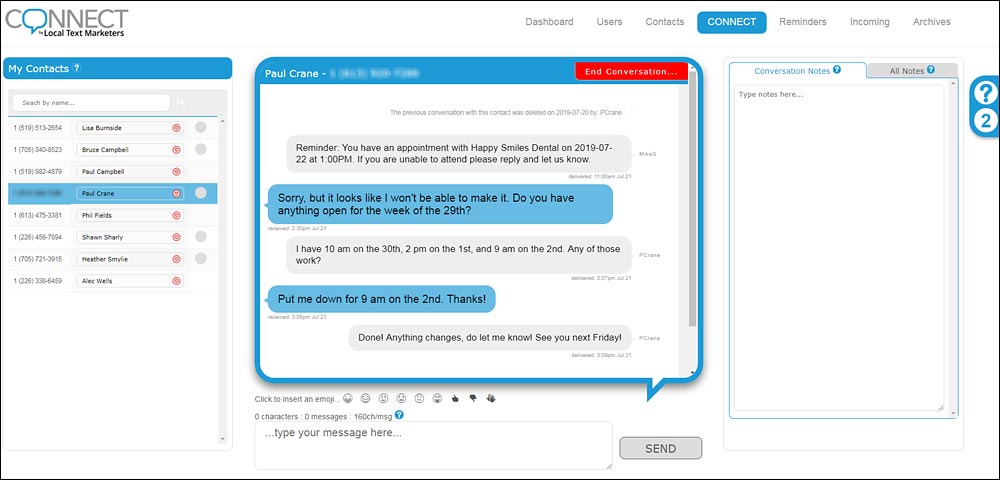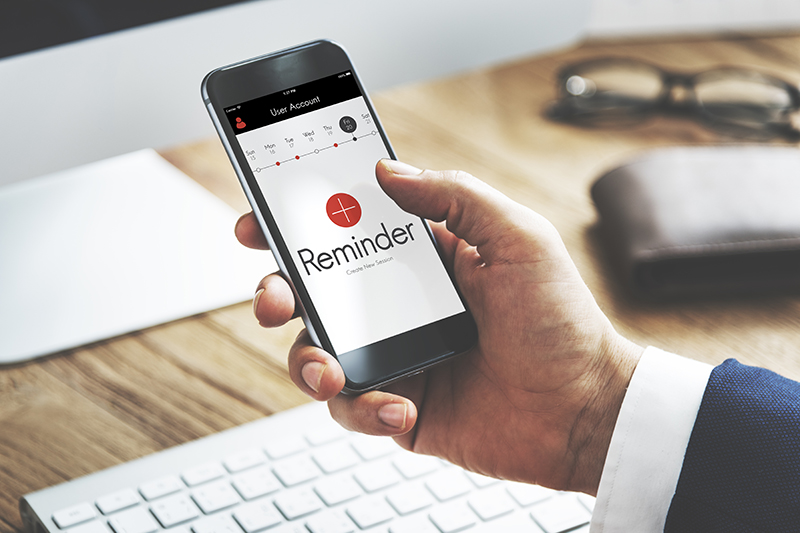Reduce No Shows with Automated Text Reminders
If you own or manage a service business and you’re reading this, automated text reminders are important you, whether you know it yet or not.
You already know the impact that missed appointments and no shows are having on your bottom line. And it’s no trifling amount.
As an example…
For governments providing healthcare, the numbers are truly staggering – the cost of missed healthcare appointments in the US is an estimated $150 billion. In Canada, some data suggests as many as 1 in 10 appointments are missed.
For private businesses and clinics, it’s a little harder to find numbers. However, I’ve seen it estimated that service businesses with a yearly income of roughly $120,000 can expect missed appointments and no shows to cost as much $26,000, or roughly 22% of total annual revenue.
That’s a lot of money.
The Problems with Missed Appointments and No Shows
The most obvious problem with a missed appointment is that it deprives your business of revenue.
But that’s not the only problem. Some others?
- You still have to pay your employees who are unable to serve clients who don’t show up.
- It’s difficult to allocate resources properly.
And even worse…
- It can seriously mess up your business’ ability to operate efficiently and depending on your policies, cause even more problems for you.
For example, if a client doesn’t show up on time, do you wait 10 or 15 minutes in the hope that they do, and as a result, throw off your entire schedule?
And how do you think this makes customers who arrive on time feel?
Will they be annoyed to have their own schedules impacted and become upset with you because you’re prioritizing clients who don’t show up over those that do?
What a nightmare!
The Silver Lining…
If there’s any good news, it’s that this situation can be remedied with automated text reminders.
In fact, I would argue that for most businesses, the fastest and cheapest way to boost your revenue—without a single new customer—is to eliminate these forgotten appointments as much as possible and streamline your communication efficiency.
For those of you who are new to them, automated text reminders are short, automated text message sent to your client in advance of an upcoming appointment that reminds them of its date and time.
Why Automated Text Reminders?
Why send a text message reminder when you can send an email or leave a voicemail? What’s so special about them? What advantage does sending a text have over other communication options?
These are really good questions.
Here’s what it boils down to…
- As more and more people drop their landlines and switch to cell phones, voice calls are viewed as disruptive. They interrupt your client and force them to stop what they are doing. In addition, if your clients are like most people, voice calls almost always originate from outside of their immediate social circle (the people closest to them know to text them, not to call), and as a result, are downgraded in priority.
- There’s nothing special about emails and as a result, viewing and responding to them is seldom prioritized. Plus, the value of email has been so diluted by spam and marketing messages that’s it’s simply too easy to miss an email notification of an upcoming appointment.
On the other hand…
- Texting is a comfortable, cheap and unintimidating technology that everyone uses. Most importantly, it’s a highly personal communication channel. Text messages almost always originate from someone in your social circle—friends, colleagues, spouse, family, and loved ones—people with whom you have a personal relationship. This, in a nutshell, is why reading a text message is always of such a high priority to you and me. When you deliver your reminder via text message, you’re communicating on the most personal of channels and the one in which your client is most interested.
How Well Do Automated Text Reminders Work?
I’m sure you’d be understandably skeptical of any results I provided based on our own clients’ experiences.
After all, we’re a commercial provider of automated text reminders and as a result, have a financial conflict of interest. Plus, testimonials are almost impossible to verify and super-simple to fake.
So let’s forget about what I have to say. Instead, let’s turn to science.
Yep. You heard that right. Science.
The “missed appointment” and “no show” phenomena is a huge, global problem and as a result, a number of published, peer-reviewed clinical studies have been conducted on the issue.
What Do The Scientific Studies Say?
All the studies about automated text reminders were unambiguous in their conclusions…
Text messages helped reduce “did not attend” and “failed to attend” rates. Some results were quite dramatic, some were less so, but all were clear… they work for pretty much any type of appointment.
For example, a study published in the Australian Health Review found that text reminders reduced “failure to attends” by almost 50% and concluded…
“The cost of sending the SMS reminders was small compared with the increase in patient revenue and associated benefits generated as a result of improved attendance.”
This study found that using text reminders reduced the DNA (did not attend) rate in a general ophthalmology clinic from 12% to 5.5%.
And this is just the tip of the iceberg when it comes to supporting clinical studies…
- Here’s one conducted in China, using SMS reminders to boost attendance to follow up appointments for pediatric cataract treatment.
- Here’s another that tracked non-attendance in physical therapy clinics.
- Here’s one that tracked attendance to medical clinics in Sao Paulo, Brazil.
Bottom line?
If people have to show up at your business in order for you to get paid, using text reminders will ensure a greater percentage of them do.
The Text Reminder Solution You Choose Makes a Difference
What isn’t discussed in any of the aforementioned studies is the specifics of each SMS reminder service. This is important, because how the program is executed makes a BIG difference.
Case in point…
We did a lot of consulting with service business owners before we built our text reminder service. On one occasion, I was talking to the office manager of a local dentist who told me that her boss (the dentist) thought text reminders were a worthless—a giant pain in the ass, causing more problems than they were worth.
I was a bit surprised by this, so I asked why he felt this way.
Seems that the solution they used required clients to confirm their appointments by replying to the reminder message.
A large majority of them weren’t doing so. This caused serious upheaval in the office—if they don’t confirm their attendance, does that mean they’re not coming? Or did they simply miss the request?
In the end, sometimes it meant they weren’t coming, and other times they simply forgot to confirm the appointment and showed up at the expected time.
This confusion meant more manual follow-ups from staff and the entire purpose of the text reminders—to leverage time, boost operating efficiency and reduce no shows—all went out the window.
I Don’t Call My Doctor to Confirm My Appointment
Software is only as smart as the people building it.
Asking people to confirm attendance to an appointment makes sense on face value, but it runs completely counter to how we do things in real life, and as a result, collapses in a real-world implementation. For example, if I make an appointment with my doctor, I don’t call her office a week in advance to let her secretary know I’ll be attending.
I only call if I can’t attend. Only if there’s a change in the expected result.
Asking people to perform counter-intuitive actions leads to less ideal results, as demonstrated in my discussion with the local dental manager.
It’s also easy to imagine a client being just a tiny bit annoyed by such a message…
“Of course, I’m coming. I made the appointment and I’m an adult. What am I, like 5 years old?”
To Make Matters Worse…
To make matters worse, the people who used the text reminders to cancel their appointments? Administrative staff now have to get them back on the phone again.
And remember why you are sending automated SMS appointment reminders in the first place?
That’s right… because people don’t answer their damn phones.
The Right Solution…
… Is built based upon principles on which we are accustomed. In other words, it doesn’t require a response unless there’s a change in the expected outcome.
Unless your client is planning on cancelling her appointment, otherwise, the message functions entirely as a reminder.
Your clients aren’t 5 years old, after all. And, if they do respond indicating they can’t make it, you should be able to respond via text message, so…
- The conversation continues on the channel on which it was initiated.
- Your client sees it and replies almost immediately.
- You don’t have to go back to trying to reach them via a voice call (which is one of the inefficient, time-intensive processes you’re trying to eliminate with a texting solution).
Here’s how it looks in our CONNECTsms software…

The first message you see in the screenshot above is the automated text reminders message.
When it is sent, it automatically opens a new conversation with your client in the messaging window (if there’s an existing conversation in place, the reminder message will be added to it).
Then, if your client responds (that’s the second message), their response is added to the conversation.
Then, you or your staff can take over the conversation in the messaging window and take it to its natural conclusion (messages 3 and 5)… without ever having to pick up the phone!
Simple and intuitive. The perfect combination of automation and manual interaction (which is required only when necessary).
Try it for Yourself!
Our CONNECTsms solution ideal for automated text reminders. It is…
- Easy to use, regardless of your level of computer expertise.
- Affordable, so that all business can make use of it.
- Designed to deliver real-world improvements (increased revenue, increased communication efficiency) to your clinic or service business.
Our “no questions asked” 30-day money-back guarantee reflects our complete confidence in our software’s effectiveness.
Plus, we offer a free 30-day trial (put away your credit card, you won’t need it) so you can confirm its value before committing to a subscription.

